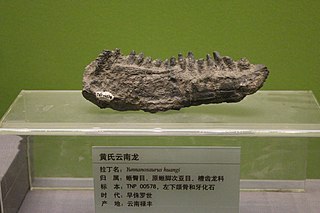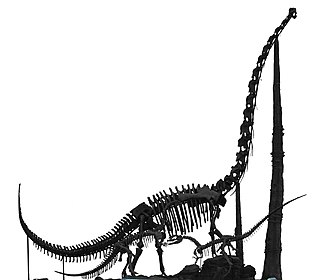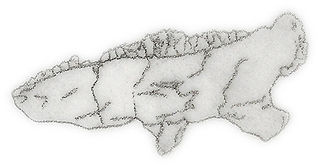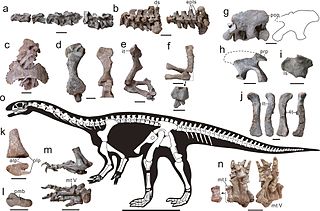Related Research Articles

Lufengosaurus is a genus of massospondylid dinosaur which lived during the Early Jurassic period in what is now southwestern China.

Yunnanosaurus is an extinct genus of sauropodomorph dinosaur that lived approximately 199 to 183 million years ago in what is now the Yunnan Province, in China, for which it was named. Yunnanosaurus was a large sized, moderately-built, ground-dwelling, quadrupedal herbivore, that could also walk bipedally, and ranged in size from 7 meters (23 feet) long and 2 m (6.5 ft) high to 4 m (13 ft) high in the largest species.

Sinosaurus is an extinct genus of theropod dinosaur which lived during the Early Jurassic Period. It was a bipedal carnivore approximately 5.5 metres (18 ft) in length and 300 kilograms (660 lb) in body mass. Fossils of the animal were found at the Lufeng Formation, in the Yunnan Province of China.

Gyposaurus is a genus of basal sauropodomorph dinosaur from the early Jurassic of South Africa. It is usually considered to represent juveniles of other prosauropods, but "G." sinensis is regarded as a possibly valid species.
Dianchungosaurus is an extinct genus of mesoeucrocodylian crocodylomorph from the Early Jurassic of China. It was previously considered a dinosaur, but it was recently reclassified as a mesoeucrocodylian by Paul Barrett and Xing Xu (2005). It is probably the same animal as the informally named "Tianchungosaurus". The type species is D. lufengensis and it was described in 1982. A second species, D. elegans, was named in 1986, but it has since become a synonym of the type species.

Chuanjiesaurus is a genus of sauropod dinosaurs from the middle Jurassic Period. They lived in what is now China. The type species, Chuanjiesaurus anaensis, was first described by Fang, Pang, Lü, Zhang, Pan, Wang, Li and Cheng in 2000. Fossils of the species were found in the village of Chuanjie, Lufeng County, Yunnan Province, and are named after the location where the fossils were discovered. Holtz gave a length of 25 meters.

Tatisaurus is a genus of ornithischian dinosaur from the Early Jurassic from the Lower Lufeng Formation in Yunnan Province in China. Little is known as the remains are fragmentary. The type species is T. oehleri.
Eshanosaurus is a genus of a dinosaur from the early Jurassic Period. It is known only from a fossil partial lower jawbone, found in China. It may be a therizinosaurian, and if so the earliest known coelurosaur.
Fulengia is a dubious genus of basal sauropodomorph dinosaur from the Early Jurassic Lufeng Formation of China.

Lukousaurus is an archosauromorph based on most of a small skull's snout, displaying distinctive lachrymal horns, found in the Early Jurassic-age Lower Lufeng Formation, Yunnan, China and was described by Chung Chien Young in 1940. The generic name refers to the Lugou Bridge, lit. “crossroads”, near Beijing, where the Sino-Japanese War started. L. yini is tentatively classified as a theropod dinosaur by some allied to ceratosaurs, by others a coelurosaur. Its skull is rather robust for its size though the teeth were described by the author as typically theropodan. Whatever Lukousaurus was, it was definitely an archosauromorph.
The Lufeng Formation is a Lower Jurassic sedimentary rock formation found in Yunnan, China. It has two units: the lower Dull Purplish Beds/Shawan Member are of Hettangian age, and Dark Red Beds/Zhangjia'ao Member are of Sinemurian age. It is known for its fossils of early dinosaurs. The Dull Purplish Beds have yielded the possible therizinosaur Eshanosaurus, the possible theropod Lukousaurus, and the "prosauropods" "Gyposaurus" sinensis, Lufengosaurus, Jingshanosaurus, and Yunnanosaurus. Dinosaurs discovered in the Dark Red Beds include the theropod Sinosaurus triassicus, the "prosauropods" "Gyposaurus", Lufengosaurus, and Yunnanosaurus, indeterminate remains of sauropods, and the early armored dinosaurs Bienosaurus and Tatisaurus.

Dibothrosuchus is a genus of sphenosuchian, a type of basal crocodylomorph, the clade that comprises the crocodilians and their closest kin. It is known from several partial skeletons and skulls. These fossils were found in Lower Jurassic rocks of Yunnan, China. Dibothrosuchus was a small terrestrial crocodylomorph that probably had a keen sense of hearing, and thus was probably a vocal animal like modern crocodilians.
Microchampsa is an extinct genus of protosuchian crocodylomorph that existed during the Early Jurassic. Fossils have been found from stratum 6 of the Dahuangtian locality, an outcrop of the Lower Red Beds of the Lufeng Formation in Yunnan, China.

Platyognathus is an extinct genus of protosuchian crocodylomorph. Fossils are known from the Early Jurassic Lower Lufeng Formation in Yunnan, China and belong to the type and only species, P. hsui.
Pachysuchus is a dubious extinct genus of basal sauropodomorph dinosaur from the Early Jurassic of China.
Xixiposaurus is a genus of "prosauropod" dinosaur which existed in what is now Lower Lufeng Formation, China during the lower Jurassic period. It was first named by Sekiya Toru in 2010 and the type species is X. suni.
Chuxiongosaurus is a genus of basal sauropodomorph dinosaur which lived during the Early Jurassic Period. Fossils of this genus have been found in the Lower Lufeng Formation, Yunnan Province, southern China. Identified from the holotype CMY LT9401 a nearly complete skull with some similarities to Thecodontosaurus, it was described as the "first basal sauropod dinosaur from the Early Jurassic of China," more basal than Anchisaurus. It was named by Lü Junchang, Yoshitsugu Kobayashi, Li Tianguang and Zhong Shimin in 2010, and the type species is Chuxiongosaurus lufengensis.

Xingxiulong is a genus of bipedal sauropodiform from the Early Jurassic of China. It contains a single species, X. chengi, described by Wang et al. in 2017 from three specimens, two adults and an immature individual, that collectively constitute a mostly complete skeleton. Adults of the genus measured 4–5 metres (13–16 ft) long and 1–1.5 metres tall. Phylogenetic analysis suggests that Xingxiulong is most closely related to its contemporary Jingshanosaurus, although an alternative position outside of both the Sauropodiformes and Massospondylidae is also plausible.
Shuangbaisaurus is genus of theropod dinosaur, possibly a junior synonym of Sinosaurus. It lived in the Early Jurassic of Yunnan Province, China, and is represented by a single species, S. anlongbaoensis, known from a partial skull. Like the theropods Dilophosaurus and Sinosaurus,Shuangbaisaurus bore a pair of thin, midline crests on its skull. Unusually, these crests extended backwards over the level of the eyes, which, along with the unusual orientation of the jugal bone, led the describers to name it as a new genus. However, Shuangbaisaurus also possesses a groove between its premaxilla and maxilla, a characteristic which has been used to characterize Sinosaurus as a genus. Among the two morphotypes present within the genus Sinosaurus, Shuangbaisaurus more closely resembles the morphotype that is variably treated as a distinct species, S. sinensis, in its relatively tall skull.
Analong is a genus of mamenchisaurid sauropod dinosaur from the Chuanjie Formation in Yunnan, China. The type and only species is Analong chuanjieensis.
References
- ↑ Dong, Z. (1980). "Chinese dinosaur faunas and their stratigraphic position" (PDF). Journal of Stratigraphy. 4 (4): 256–263.
- ↑ Simmons, D.J. (1965). "The non-therapsid reptiles of the Lufeng Basin, Yunnan, China". Fieldiana Geology. 15: 1–93. doi: 10.5962/bhl.title.5426 .
- ↑ Parrish, J.M. (1987). "The origin of crocodilian locomotion" (PDF). Paleobiology. 13 (4): 396–414. doi:10.1017/S0094837300009003. S2CID 85804935.
- ↑ Padian, K. (1989). "Did "thecodontians" survive the Triassic?". In Lucas, S.G.; Hunt, A.P. (eds.). Dawn of the Age of Dinosaurs in the American Southwest. Albuquerque: New Mexico Museum of Natural History. pp. 401–414.